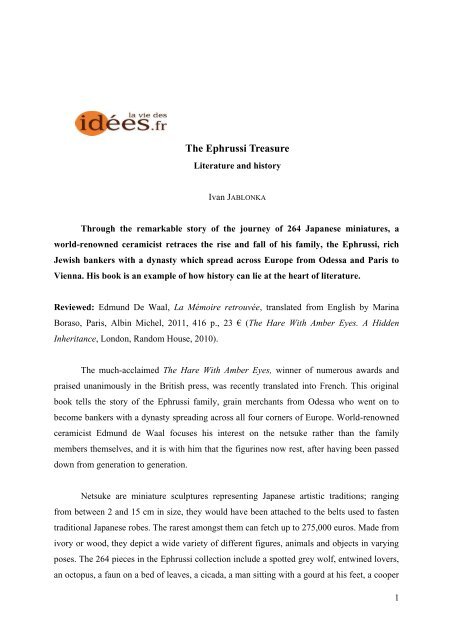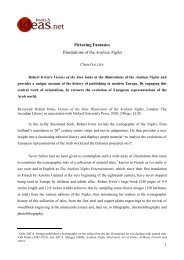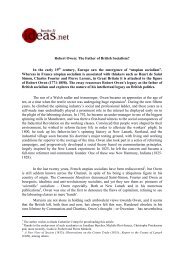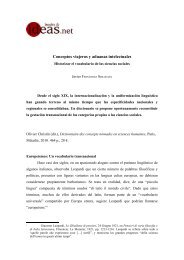The Ephrussi Treasure - Books & ideas
The Ephrussi Treasure - Books & ideas
The Ephrussi Treasure - Books & ideas
Create successful ePaper yourself
Turn your PDF publications into a flip-book with our unique Google optimized e-Paper software.
<strong>The</strong> <strong>Ephrussi</strong> <strong>Treasure</strong><br />
Literature and history<br />
Ivan JABLONKA<br />
Through the remarkable story of the journey of 264 Japanese miniatures, a<br />
world-renowned ceramicist retraces the rise and fall of his family, the <strong>Ephrussi</strong>, rich<br />
Jewish bankers with a dynasty which spread across Europe from Odessa and Paris to<br />
Vienna. His book is an example of how history can lie at the heart of literature.<br />
Reviewed: Edmund De Waal, La Mémoire retrouvée, translated from English by Marina<br />
Boraso, Paris, Albin Michel, 2011, 416 p., 23 € (<strong>The</strong> Hare With Amber Eyes. A Hidden<br />
Inheritance, London, Random House, 2010).<br />
<strong>The</strong> much-acclaimed <strong>The</strong> Hare With Amber Eyes, winner of numerous awards and<br />
praised unanimously in the British press, was recently translated into French. This original<br />
book tells the story of the <strong>Ephrussi</strong> family, grain merchants from Odessa who went on to<br />
become bankers with a dynasty spreading across all four corners of Europe. World-renowned<br />
ceramicist Edmund de Waal focuses his interest on the netsuke rather than the family<br />
members themselves, and it is with him that the figurines now rest, after having been passed<br />
down from generation to generation.<br />
Netsuke are miniature sculptures representing Japanese artistic traditions; ranging<br />
from between 2 and 15 cm in size, they would have been attached to the belts used to fasten<br />
traditional Japanese robes. <strong>The</strong> rarest amongst them can fetch up to 275,000 euros. Made from<br />
ivory or wood, they depict a wide variety of different figures, animals and objects in varying<br />
poses. <strong>The</strong> 264 pieces in the <strong>Ephrussi</strong> collection include a spotted grey wolf, entwined lovers,<br />
an octopus, a faun on a bed of leaves, a cicada, a man sitting with a gourd at his feet, a cooper<br />
1
wielding an adze, an abundance of rats and rat-catchers, fish, medlar plants, and the<br />
eponymous chef-d’œuvre, a hare with amber eyes. <strong>The</strong> figurines in this magnificent<br />
collection, similar in size to Edmond de Goncourt’s collection of 140 miniatures which he<br />
amassed in the 19 th century, as well as others numbering up to 200, are as valuable for the<br />
variety of figures they depict as they are for their cream-coloured and mahogany shading,<br />
their sheen and patina, and their lightness and artistic finesse. On one netsuke, the carver’s<br />
signature can be found on the thorax of a hornet! Edmund de Waal carries them each in turn<br />
with him for the day, as though the pulse of his ancestors can still be felt vibrating through<br />
them:<br />
A netsuke is so light and so small that it migrates and almost disappears amongst your<br />
keys and change. […] I intermittently roll this thing through my fingers. I realise how<br />
much I care about how this hard-and-soft losable object has survived. (p. 24-25)<br />
This fascination with the netsuke has more to it than simple aesthetic pleasure. De<br />
Waal may well feel a sense of responsibility for the figures, since they represent a spiritual<br />
inheritance. Having survived a century of European history, these delicate objects are all that<br />
is left of the <strong>Ephrussi</strong> family, one of the largest Jewish families of the 19 th century along with<br />
the Rothschild, Camondo and Cattaui families. <strong>The</strong> journey of these netsuke forms the subject<br />
of the book; first purchased in Paris in the 1870s by a distant cousin, Charles <strong>Ephrussi</strong>, and<br />
offered as a wedding present to Viktor <strong>Ephrussi</strong>, a banker in Vienna in the early 20 th century<br />
and the author’s great-grandfather, they were finally taken to Tokyo in 1950 by a great-uncle<br />
named Iggie.<br />
Paris, Vienna, Tokyo<br />
From docks, canals, and the bridges being built over the Danube to the railways<br />
crossing France and Russia, the <strong>Ephrussi</strong> family fortune had investments in it all. Named the<br />
“Kings of Grain,” the family decided in the 1860s to send their sons to establish family<br />
branches in different countries across Europe. Paris, <strong>The</strong> City of Light and capital of the Arts,<br />
fell to Charles (1849-1905). <strong>The</strong> young man became a member of the most fashionable<br />
salons, kept company with the highest echelons of society and spent his free time hunting for<br />
2
antiques with his mistress, Louise Cahen d’Anvers. It was around this time that Japonisme<br />
was all the rage; Monet painted La Japonaise and began to collect engravings, Proust’s<br />
Odette, dressed in a kimono, receives Swann in a room decorated with screens and lanterns,<br />
and Charles and his mistress became obsessed with lacquer and ivory, ceramics, bronze<br />
statues, fans, trinkets and Japanese robes. Charles kept his new netsuke laid out on a length of<br />
green velvet in a dark wooden display cabinet with a mirror at the back so that the collection<br />
appeared even larger. Around the same period, he acquired over sixty new Impressionist<br />
masterpieces, including ones by Monet, Cassatt, Morisot, Sisley, and Pissarro, as well as<br />
Manet’s Une botte d’asperges (A Bunch of Asparagus) (1880). As time went by, Charles,<br />
nicknamed “the Benedictine dandy of the rue de Monceau” by his secretary, poet Jules<br />
Laforgue, gradually lost interest in high-society and became an avid art historian, collector<br />
and patron of the arts.<br />
However, the <strong>Ephrussi</strong> wealth inspired both envy and hatred. When Renoir found out<br />
that Charles, a patron of his, also liked the works of Gustave Moreau, he gave vent to his<br />
bitterness: “It was clever of him [Moreau] to take in the Jews, to have thought of painting<br />
with gold colours…even <strong>Ephrussi</strong> fell for it!” (p.106) Against the backdrop of various<br />
scandals all involving Jewish businessmen, the Goncourt brothers proclaimed the salons to be<br />
“infested with Jews and Jewesses.” In 1894, the Dreyfus affair erupted.<br />
As the <strong>Ephrussi</strong> heyday waned and all things Japanese passed out of style, the netsuke<br />
began a new life in Vienna, where they were sent in 1899 as a wedding gift for cousin<br />
Viktor’s wedding with the beautiful Emmy. With a fortune worth millions, Viktor <strong>Ephrussi</strong><br />
(1860-1945), son of a Gründer (a pioneer in new Austria), divided his time between the<br />
family palace on Vienna’s Ringstrasse and their country house, Kövesces, located in the<br />
former Czechoslovakia two hours by train from Vienna. Jews in Austria had had full civic<br />
rights, including the right to education and property ownership, since 1867. Much like in the<br />
Monceau district of Paris, they flourished under Emperor Franz Josef’s reign, with the<br />
bankers and industrialists amongst them buying up huge swathes of land, engaging in<br />
financial speculation and extravagantly high bidding, and holding impossibly magnificent<br />
3
parties in their étage noble ballrooms. All these stucco and marble palaces, referred to as<br />
‘architectural fireworks’ by De Waal (p.144) were in stark contrast to the rather more modest<br />
netsuke. However, the humble miniatures were in no way outshone by their grander<br />
surroundings, and the <strong>Ephrussi</strong> children would often play with the little boxwood mouse, the<br />
half naked wrestler preparing to jump, the hunted stag and that hare with the amber eyes,<br />
much like others would line their lead soldiers up on the carpet.<br />
When Austria declared war in 1914, the family’s French servants had to pack their<br />
bags and leave the Ringstrasse to return to France. <strong>The</strong> family were already divided; Viktor<br />
and the <strong>Ephrussi</strong> bank in Vienna were on hostile terms with the other branches of the family,<br />
namely <strong>Ephrussi</strong> et Cie at the Rue de l’Arcade in Paris, <strong>Ephrussi</strong> and Co of King Street in<br />
London and the Efrussi branch in Petrograd. Ruined by inflation, the effects of the war and<br />
his catastrophic refusal to have his wealth transferred from Austria, Viktor was left with<br />
nothing but his palace on the Ringstrasse and the netsuke lying in their cabinet, no doubt<br />
forgotten.<br />
One by one, the family’s children left Vienna. Elisabeth, fascinated in philosophy and<br />
economics and in correspondence with Rilke, as well as being the first woman to receive a<br />
doctorate of law from the University of Vienna, moved to the United States where she went<br />
on to marry a Dutchman named De Waal. Her sister Gisela emigrated to Madrid with her<br />
husband in 1925, while Iggie moved to Paris to become a dress designer. Soon after the<br />
Anschluss, the Nazi policy of plundering began. This was the final blow for the <strong>Ephrussi</strong><br />
family: “<strong>The</strong> house wasn’t theirs anymore. It was full of people, some in uniform and some in<br />
suits. People counting rooms, making lists of objects and pictures, taking things away.”<br />
(p. 295) Jews would sometimes sell their possessions in order to pay the Reichsfluchtsteuer so<br />
that they could escape the country. On 12 August 1938, the <strong>Ephrussi</strong> company name was<br />
crossed off the Commercial Register.<br />
And what happened to the little Japanese figurines? After the war, Elisabeth returned<br />
to the house in Vienna and heard from Anna, the family maid, how everything had been<br />
4
ansacked and pillaged by the Nazis: “And they didn’t notice. <strong>The</strong>y were so busy. <strong>The</strong>y were<br />
busy with all the grand things […] And I put them in my mattress and I slept on them.”<br />
(p. 323) A brave and deeply moving gesture from a servant who would otherwise have been<br />
invisible to the <strong>Ephrussi</strong> family. Anna returned the 264 netsuke to Elisabeth, whose brother<br />
Iggie (1906-1994), fluent in German, English and French, went on to become an Intelligence<br />
Officer in the American Army and moved to Tokyo as a grain exporter. This descendent of<br />
the “Kings of Grain” took the netsuke with him, bringing the family story of grain and<br />
netsuke full circle. <strong>The</strong> figures found themselves once more on show in a glass cabinet, this<br />
time in a post-war Tokyo salon with a view looking out onto a camellia garden. This was their<br />
final resting place before being inherited by Edmund De Waal and travelling with him to<br />
London.<br />
Across the Diaspora<br />
<strong>The</strong> netsuke’s native Japan to which they returned represented but an illusory oasis of<br />
peace after the monstrous events, anti-Semitism, Anschluss, war and mass murder which had<br />
destroyed Europe; many of the atrocities committed before and after the Second World War<br />
were to a significant degree committed in the name of Japanese imperialism.<br />
Before the apocalyptic events of the war, the netsuke had represented a closed<br />
microcosm for the <strong>Ephrussi</strong> children. “<strong>The</strong>y h[e]ld themselves inwards” (p. 324), they were<br />
self-sustaining, and their longevity and hardness inspired a type of trust. <strong>The</strong>se hares, ropes,<br />
medlars and nut shells represented a stability that existed despite the upheaval the world had<br />
experienced. Viktor, a Viennese Russian for half a century, went on to became stateless; his<br />
daughter Elisabeth, born in Vienna, acquired Dutch nationality; Iggie went from being<br />
Austrian to American and finally back to Austrian residing in Japan. <strong>The</strong> <strong>Ephrussi</strong> glory had<br />
been erased, and their paintings, automobiles, robes and properties plundered. <strong>The</strong> netsuke,<br />
however, remained as they were, unchanged. In their perfection, they seem immune to age<br />
and decay. <strong>The</strong>ir beauty is almost scandalous—“why should they have got through this war in<br />
a hiding-place when so many hidden people did not?”<br />
5
However, once again, their immutability is merely illusory. <strong>The</strong>se infinitely fragile<br />
beings, the height of refinement, need our protection; locked away behind glass, hidden under<br />
a mattress or carried in pockets, it is man’s protection which affords them their unassailable<br />
solidity and which allows them to survive journeys, exile, pillaging and war. Despite their<br />
substantial density, their permanence and their polish, the netsuke are not detached from<br />
history. On the contrary, history invades their glass cabinet. As De Waal writes, quoting<br />
Virgil’s “sunt lacrimae rerum,” “there are tears in things” (Daniel Mendelsohn uses the same<br />
phrase in <strong>The</strong> Lost 1 ).<br />
<strong>The</strong> netsuke are, however, accessible to mortals, despite their immortality. Each<br />
individual owns them in their own way; Charles the dandy shows them off to his friends; the<br />
children in the <strong>Ephrussi</strong> palace roll them across carpets; in a temple in the suburbs of Tokyo,<br />
the author says a kaddish in memory of his relative Iggie, exiled from Vienna. Emotional<br />
investment, familiarity, inheritance, preservation and displacement all leave their mark on the<br />
netsuke; that of the disintegration of a family. <strong>The</strong>re is a connection between the fragile yet<br />
stable netsuke that preserve their integrity despite the change and uncertainty around them,<br />
and life in a diaspora, with its exiles, dispersion, distance, and faithful continuity in spite of<br />
the oblivion which threatens to overwhelm.<br />
A Discourse on History<br />
<strong>The</strong>re is, however, something more important, which is why <strong>The</strong> Hare With Amber<br />
Eyes touched me as it did. <strong>The</strong> book, with its psychological subtlety, its journey into time and<br />
space, its narrative overlapping, nostalgia, and exploration of the world of childhood, is also a<br />
history book (although the word “history” here is not to be taken in its common sense, where<br />
the slightest mention of Haussmannian architecture or the Second World War warrants the<br />
status of a historical piece). I also attempted the combination of history and literature in a<br />
family biography entitled Histoire des grands-parents que je n’ai pas eus [A history of the<br />
grandparents I never had] (Seuil, 2012). <strong>The</strong> following lines are as much an account as they<br />
1 Daniel Mendelsohn, <strong>The</strong> Lost: A Search for Six of Six Million, Harper, First Edition edition, 2006; reviewed in<br />
French in La Vie des Idées, http://www.laviedesidees.fr/Comment-raconter-la-Shoah.html.<br />
6
are a justification for a particular perception of history, and also of literature.<br />
De Waal narrates as a writer and reasons as a historian. <strong>The</strong> questions he asks himself<br />
and the reader go far beyond the particular details of his family and the colourful characters of<br />
which it is composed. <strong>The</strong> different branches of the family and its fortunes spread throughout<br />
Europe in the 19 th century, the superficial assimilation of the western Jews caught between<br />
emancipation and the Holocaust, the migration of entire families, the movement of<br />
possessions, 2 and the uniqueness of art at a time of mass industrialisation are all discussed. Of<br />
course, De Waal only tackles these questions by examining a few particular characters and<br />
their fates, each linked one with the other through their filiation and inheritance of the<br />
netsuke. However, it is precisely through this focus on certain paradoxes of modernity that<br />
this book of interwoven histories is able to show how little rupture there is between our<br />
personal family histories and what we imagine to be universal “History,” how little<br />
heterogeneity between the anonymous masses and the most renowned, between the intimacy<br />
of memories, the progression of individual lives and that vast public space that we call the<br />
past.<br />
In order to question, obliquely and in a fragmentary way, this past, De Waal uses rich<br />
and varied sources, including family memories and stories, archives unearthed in France and<br />
Austria, newspapers, masterpieces and other art objects.<br />
2 For similar themes, see Timothy Brook, Vermeer’s Hat. <strong>The</strong> Seventeenth Century and the Dawn of the Global<br />
World, New York, Bloomsbury Press, 2008.<br />
7
Typology of the sources (oral, manuscript, printed and material) used in <strong>The</strong> Hare<br />
with Amber Eyes by Edmund De Waal:<br />
– family memories (taken from the author’s grandmother Elisabeth and his greatuncle<br />
Iggie);<br />
– family archives (letters, account books, balance sheets, opera and theatre ticket<br />
books, photo albums, one of which showed Emmy and the archduke in 1907);<br />
– public archives (archives from the Louvre, registers from the Rabbinate of<br />
Vienna, Adler company archives, Deutsche Bank files relating to the transfer of <strong>Ephrussi</strong><br />
assets after the Second World War) ;<br />
– periodicals, primarily on art and fashion (the “Society” columns of the Gaulois,<br />
specialist reviews such as La Gazette des Beaux-Arts, Allgemeine Bauzeitung and<br />
Women’s Wear Daily) ;<br />
– prints (Charles <strong>Ephrussi</strong>’s Albert Dürer et ses dessins, collection catalogues, the<br />
La France juive [Jewish France] pamphlet by Drumont, the Journal of the Goncourt<br />
brothers) ;<br />
– relevant works of fiction (Du côté de chez Swann, in which Proust takes<br />
inspiration for Swann’s character from two sources, Charles <strong>Ephrussi</strong> and Charles Haas,<br />
both art lovers, men of the world and Jewish; also, Karl Kraus, Musil, Schnitzler and La<br />
Marche de Radetzky [Radetzky March] in which Trotta deposits his wealth at the Efrussi<br />
bank in 1900 Vienna);<br />
– paintings (Le Pont de l’Europe [<strong>The</strong> Europe Bridge] by Caillebotte, Le Déjeuner<br />
des canotiers [Luncheon of the Boating Party] by Renoir in which Charles <strong>Ephrussi</strong><br />
features, out of place in his black suit and his top-hat, and Pips au piano by Joseph<br />
Olbrich, one of the pillars of the Secession Style);<br />
– art objets (Japanese lacquer ware, furniture and of course, netsuke);<br />
– buildings and monuments (maps of capital cities, private mansions in Paris and the<br />
<strong>Ephrussi</strong> palace on Vienna’s Ringstrasse built by Hansen).<br />
In using such diverse sources, the author is not merely being open-minded but also<br />
wishes to provide the reader with evidence for his story. <strong>The</strong>re are certainly no sacred<br />
footnotes in <strong>The</strong> Hare With Amber Eyes, and analysis of the archives is far from systematic,<br />
while the bibliography is unfortunately rather sparse, a shame since recent works might have<br />
offered some interesting perspectives on Paris and Vienna at the turn of the last century. 3 This<br />
is not hugely important, however, as De Waal is not a professional historian. On the other<br />
hand, he does use the methods of a historian, whether unconsciously or intuitively. While this<br />
may seem obvious, it is still a good idea to remind ourselves that history is not only created by<br />
historians. What we see with De Waal is an artist potter who is also an author and a mapper of<br />
3 See for example Christophe Charle, Paris fin de siècle. Culture et politique, Paris, Seuil, 1998 ; Carl Schorske,<br />
Vienne fin de siècle. Politique et culture, Paris, Seuil, 1983 ; et Steven Beller, Vienne et les Juifs, 1837-1938,<br />
Paris, Nathan, 1991.<br />
8
the past, who returns to the basic principles of the discipline of history which, according to<br />
Herodotus, include inquiry, travel, discovery, passage, wandering, encounters, collecting<br />
accounts and documents, the desire to give it your all and to learn to see 4 .<br />
<strong>The</strong> Triple “I’”<br />
It is probably due to his not being a professional historian that De Waal has no<br />
scruples in using “I” to enrich his reasoning. <strong>The</strong> “I” of the investigator-narrator-author<br />
pervades the text: “I see,” “I imagine,” “I ask myself,” “I try to get my bearings,” “In libraries<br />
I stumble across things,” “I booked a ticket,” “I started a journey,” “I am not sure what I will<br />
understand,” “I cannot fight this anguish,” “I simply do not understand,” etc. It is in actual<br />
fact a triple “I,” that of the family line and of artistic heritage, that of the investigator with his<br />
original approach and haunted by questions, and that of the emotion which he inevitably feels.<br />
“I am in Vienna,” writes De Waal, “a stone’s throw from the family home, and my vision<br />
blurs.” (p. 139) <strong>The</strong> author exhibits no false modesty; he doubts, mumbles, hesitates,<br />
rummages around, grows enthusiastic, gives up, and sometimes gets lucky. He feels no shame<br />
in acknowledging all these emotions, prejudices, tremors and stumblings, because they are an<br />
integral part of the research process and are grounded in honesty. His quest is transparent and<br />
his confession tinged with modesty.<br />
<strong>The</strong> author’s constant toing and froing between the family’s past and the present in<br />
which he, as a researcher, ceramicist, descendant and father now finds himself is a<br />
fundamental part of the book. Himself an artist, clients and patrons also visit De Waal in his<br />
South London studio, stuck between a Caribbean fast-food restaurant and a car repair shop.<br />
His empathy and profession allows him to better understand his grandfather: “It is very<br />
strange for me to be reading so much about Charles as a patron and his friendship with Renoir<br />
and Degas. It is not just the vertiginous descent from doing the commissioning to being<br />
commissioned.” (p. 103) Historians should not be afraid of their “I,” of their intimacy, not<br />
even of their doubts; investigators always conjugate their research in the present. Such<br />
4 François Hartog, L’Histoire d’Homère à Augustin, Seuil, coll. “Points,” 1999, p. 53 ; and, more generally, <strong>The</strong><br />
Mirror of Herodotus: the Representation of the Other in the Writing of History, Berkeley, University of<br />
9
apparent audacity on their part would lead only to an increased reflexivity in their approach.<br />
In <strong>The</strong> Hare With Amber Eyes, the variety of sources used, their cross-referencing, the<br />
preoccupation with proving what is said, the obsession not only with reality but also with<br />
materiality such as statues, objects and clothes, shows that historical and sociological<br />
reasoning can be found at the heart of what is literary. It is not a question here of defining<br />
what the word “literature” means, even if that were possible. I will content myself by saying<br />
that literature creates emotion through the medium of writing and form. This somewhat rough<br />
definition nevertheless possesses two main advantages: simplicity, which allows for the<br />
inclusion of all texts, and plasticity, which renders literature entirely compatible with research<br />
and the social sciences. It is actually possible to create texts which are inextricably both<br />
history and literature at once, the understanding being of course that the latter is not<br />
automatically reduced to fiction. I was thus able to define my Histoire des grands-parents que<br />
je n’ai pas eus [A history of the grandparents I never had] as non-fiction literature which<br />
satisfies certain methodological requirements. In this respect, De Waal is much more of a<br />
historian than Mendelsohn, although this statement is in no way an indictment of the quality<br />
of their respective works. <strong>The</strong> narrative and cognitive experiments so brilliantly accomplished<br />
by them have very little in common with those fictionalised history books which, in<br />
attempting to be both history and novel simultaneously, end up as nothing at all.<br />
Hybrid texts such as <strong>The</strong> Hare with Amber Eyes shed new light on the rich debate,<br />
ongoing for several years, surrounding the relationship between historians and literature. 5 It is<br />
crucial not to define the debate along professional lines, as this would lead to two separate<br />
genres, with Balzac the writer on one side and Braudel or Bourdieu the scholar on the other. It<br />
is equally important not to make of literature a vaguely fascinating timeless entity that<br />
California Press, 1988.<br />
5 For the most noteworthy publications, see Judith Lyon-Caen, Dinah Ribard, L’Historien et la Littérature,[<strong>The</strong><br />
historian and literature], Paris, La Découverte, coll. “Repères,” 2010, reviewed on the Fabula website<br />
(http://www.fabula.org/revue/document6403.php); see also the special edition of the Annales, “Savoirs de la<br />
littérature,” [Knowledge of literature], 65th year, n° 2, March-April 2010. La Vie des Idées organised a talk with<br />
Patrick Boucheron, Florent Brayard, Judith-Lyon-Caen and Dinah Ribard (http://www.laviedesidees.fr/Lalitterature-une-science-sociale.html)<br />
to mark its publication.<br />
10
historians should contemplate dreamily or manipulate carefully at their little desks. Much like<br />
a ceramicist can be a historian, a historian can be a writer, by combining a sensitivity for<br />
human beings, the world and objects, a reflexive “I,” a narrative construction and scientific<br />
procedures with the emotion created precisely by the unresolved tension between all these<br />
different elements. It is therefore possible for historians to create literature without sacrificing<br />
their role as historians, and whilst remaining loyal to methodology and mindful of producing<br />
truthful discourse.<br />
Further resources:<br />
– Reviews of the book<br />
in <strong>The</strong> Telegraph :<br />
http://www.telegraph.co.uk/culture/books/7832582/<strong>The</strong>-Hare-With-Amber-Eyes-A-Hidden-<br />
Inheritance-by-Edmund-de-Waal-review.html<br />
in <strong>The</strong> Guardian :<br />
http://www.guardian.co.uk/books/2010/jun/26/hare-amber-eyes-de-waal<br />
– Edmund De Waal’s personal site: http://www.edmunddewaal.com/<br />
– A filmed interview with Edmund De Waal :<br />
http://www.youtube.com/watch?v=xnCjLXQAnmo<br />
– Websites on netsuke:<br />
http://www.netsuke.fr/<br />
http://www.samourais-et-ikebana.com/art_japon/netsuke.html<br />
– <strong>The</strong> exhibition « La splendeur des Camondo » [<strong>The</strong> Splendour of the House of Camondo] at the<br />
Museum of Art and History of Judaism: (2009-2010) : http://www.mahj.org/fr/3_expositions/expo-<br />
Splendeur-Camondo.php<br />
– <strong>The</strong> Camondo museum website:<br />
http://www.lesartsdecoratifs.fr/francais/nissim-de-camondo/<br />
– <strong>Ephrussi</strong> de Rothschild villa: http://www.villa-ephrussi.com/<br />
Note<br />
Thank you to Nicolas Delalande, Ariel Suhamy and Pauline Peretz for their invaluable comments.<br />
First published in laviedesidees.fr. Translated from French by Victoria Lazar Graham with the<br />
support of the Florence Gould Foundation.<br />
Published in booksand<strong>ideas</strong>.net 18 February 2011.<br />
©booksand<strong>ideas</strong>.net<br />
11








